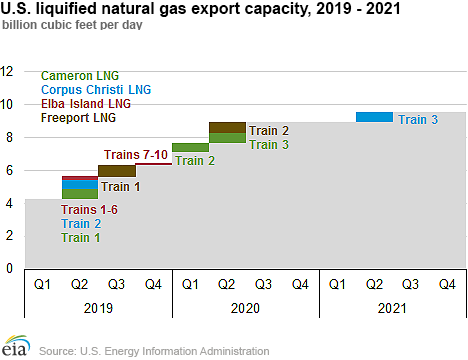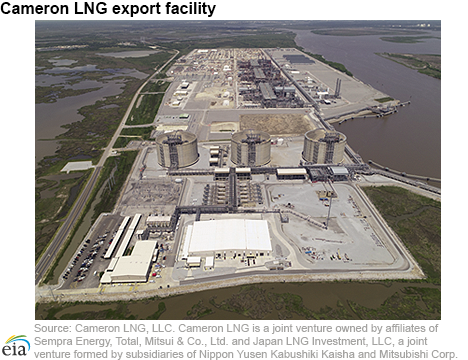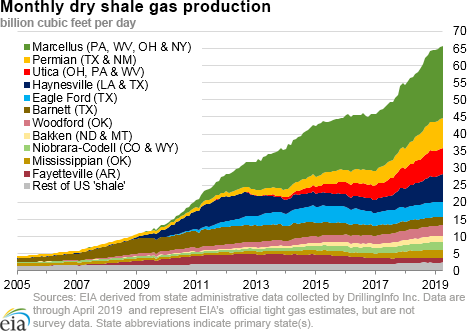In the News:
Sempra Energy begins LNG production at its 1.7 Bcf/d Cameron LNG export facility
On May 16, 2019, Sempra Energy, the majority owner of the Cameron liquefied natural gas (LNG) export facility, announced that the company has started to liquefy natural gas from the first of three liquefaction units—referred to as trains—coming online in Phase 1 of the project. Sempra Energy anticipates shipping LNG cargoes from Train 1 in the next few weeks, bringing total U.S. baseload operational LNG export capacity to about 4.8 billion cubic feet per day (Bcf/d).
Cameron LNG’s export facility is located in Hackberry, Louisiana, next to the company’s existing LNG import terminal. Phase 1 of the project includes three liquefaction units (Trains 1–3) that will export a projected 12 million tons per year of LNG exports, or about 1.7 Bcf/d.
Train 1 is currently producing LNG that will be loaded onto ships for export in the coming weeks. Trains 2 and 3 are expected to come online in the first and second quarters of 2020, according to Sempra Energy’s first quarter 2019 earnings call. Once Phase 1 is complete, the revenue associated with commercial operations of Trains 1–3 are expected to average $8.6 billion per year.
Cameron LNG has regulatory approval to expand the facility through two additional phases. Phases 2 and 3, which involve the construction of two additional liquefaction units, would increase the facility’s LNG capacity to about 3.5 Bcf/d. Phases 2 and 3 do not currently have a final investment decision.
Cameron LNG secured authorizations from the U.S. Department of Energy to export LNG to Free Trade Agreement (FTA) countries as well as non-FTA countries. In addition to Sempra Energy, which is the project’s majority owner at 50.2%, project partners include France’s Total S.A. (16.6%), Japan’s Mitsui and Co., Ltd. (16.6%), and a joint venture between Nippon Yusen Kabushiki Kaisha and Mitsubishi Corporation (16.6%).
Cameron LNG will be the fourth U.S. LNG export facility placed into service since February 2016. Currently, two new liquefaction facilities are being commissioned in the United States—Elba Island LNG in Georgia and Freeport LNG in Texas. Elba Island LNG consists of ten modular liquefaction trains, each with a capacity of 0.03 Bcf/d. The first train at Elba Island is expected to be in service this month, and the remaining nine trains will be commissioned sequentially during the following months. Freeport LNG consists of three liquefaction trains with a combined baseload capacity of 2.0 Bcf/d. The first train is expected to be placed in service during the third quarter of 2019.
For a complete list of U.S. liquefaction facilities and their status, please refer to EIA’s database of liquefaction facilities.
Overview:
(For the week ending Wednesday, May 22, 2019)
- Natural gas spot prices fell at most locations this report week (Wednesday, May 15 to Wednesday, May 22). Henry Hub spot prices remained flat at $2.61 per million British thermal units (MMBtu).
- At the New York Mercantile Exchange (Nymex), the price of the June 2019 contract decreased 6¢, from $2.601/MMBtu last Wednesday to $2.543/MMBtu yesterday. The price of the 12-month strip averaging June 2019 through May 2020 futures contracts declined 6¢/MMBtu to $2.681/MMBtu.
- Net injections to working gas totaled 100 billion cubic feet (Bcf) for the week ending May 17. Working natural gas stocks are 1,753 Bcf, which is 8% more than the year-ago level and 14% lower than the five-year (2014–18) average for this week.
- The natural gas plant liquids composite price at Mont Belvieu, Texas, fell by 13¢/MMBtu, averaging $5.61/MMBtu for the week ending May 22. The price of propane, butane, and isobutane fell by 4%, 7%, and 7%, respectively. The price of ethane rose by 3%. The price of natural gasoline remained flat week over week.
- According to Baker Hughes, for the week ending Tuesday, May 14, the natural gas rig count increased by 2 to 185. The number of oil-directed rigs fell by 3 to 802. The total rig count decreased by 1, and it now stands at 987.
Prices/Supply/Demand:
Prices fall across the country. This report week (Wednesday, May 15 to Wednesday, May 22), Henry Hub spot prices remained flat week over week at $2.61/MMBtu after reaching Monday’s high of $2.71/MMBtu. Temperatures were warmer than normal east of the Mississippi River and cooler than normal across the rest of the country. At the Chicago Citygate, prices decreased 4¢ from $2.33/MMBtu last Wednesday to $2.29/MMBtu yesterday. Prices at PG&E Citygate in Northern California fell 22¢, down from a high of $3.45/MMBtu last Wednesday to $3.23/MMBtu yesterday. Prices at SoCal Citygate decreased 21¢ from a high of $2.95/MMBtu last Wednesday to $2.74/MMBtu yesterday.
Northeastern prices decline. At the Algonquin Citygate, which serves Boston-area consumers, prices went down 7¢ from $2.32/MMBtu last Wednesday to $2.25/MMBtu yesterday. At the Transcontinental Pipeline Zone 6 trading point for New York City, prices decreased 6¢ from $2.33/MMBtu last Wednesday to $2.27/MMBtu yesterday.
Tennessee Zone 4 Marcellus spot prices were constant week over week at $2.13/MMBtu. Prices at Dominion South in southwest Pennsylvania fell 7¢ from $2.23/MMBtu last Wednesday to $2.16/MMBtu yesterday.
Permian area prices went negative during the week. Prices at the Waha Hub in West Texas, which is located near Permian Basin production activities, averaged $0.86/MMBtu last Wednesday, $1.75/MMBtu lower than Henry Hub prices. Yesterday, prices at the Waha Hub averaged just $0.01/MMBtu, $2.60/MMBtu lower than Henry Hub prices. Prices reached the lowest point of the week on Tuesday, averaging -$0.56/MMBtu, coinciding with two days of planned maintenance on the Northern Natural Gas pipeline. The maintenance was expected to conclude yesterday and had reduced flows by 200 million cubic feet per day (MMcf/d) at the Gaines county compressor station north of Midland, Texas.
Supply remains flat. According to data from PointLogic Energy, the average total supply of natural gas remained the same as in the previous report week, averaging 93.6 Bcf/d. Dry natural gas production decreased by 1% compared with the previous report week. Average net imports from Canada increased by 4% from last week.
Demand falls driven by decrease in residential and commercial sectors. Total U.S. consumption of natural gas fell by 3% compared with the previous report week, according to data from PointLogic Energy. Natural gas consumed for power generation climbed by 7% week over week with warm temperatures and cooling demand in the Southeast. Industrial sector consumption decreased by 2% week over week. In the residential and commercial sectors, consumption declined by 17% with moderate temperatures and low demand for heating. Natural gas exports to Mexico decreased 4%.
U.S. LNG exports flat week over week. Eleven LNG vessels (eight from Sabine Pass, two from Corpus Christi, and one from Cove Point) with a combined LNG-carrying capacity of 38.2 Bcf departed the United States from May 16 to May 22, according to shipping data compiled by Bloomberg. Three vessels—one at each of the terminals—were loading on Wednesday.
Storage:
Net injections into storage totaled 100 Bcf for the week ending May 17, compared with the five-year (2014–18) average net injections of 88 Bcf and last year's net injections of 93 Bcf during the same week. Working gas stocks totaled 1,753 Bcf, which is 274 Bcf lower than the five-year average and 137 Bcf more than last year at this time.
According to The Desk survey of natural gas analysts, estimates of the weekly net change from working natural gas stocks ranged from net injections of 97 Bcf to 111 Bcf, with a median estimate of 103 Bcf.
More storage data and analysis can be found on the Natural Gas Storage Dashboard and the Weekly Natural Gas Storage Report.
See also:
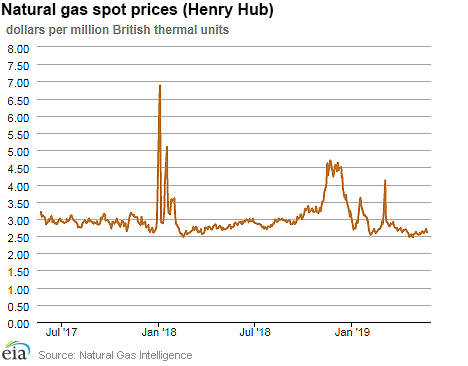
| Spot Prices ($/MMBtu) | Thu, 16-May |
Fri, 17-May |
Mon, 20-May |
Tue, 21-May |
Wed, 22-May |
|---|---|---|---|---|---|
| Henry Hub |
2.59 |
2.61 |
2.71 |
2.65 |
2.61 |
| New York |
2.24 |
2.25 |
2.28 |
2.25 |
2.27 |
| Chicago |
2.37 |
2.40 |
2.49 |
2.39 |
2.29 |
| Cal. Comp. Avg.* |
2.35 |
2.19 |
2.19 |
2.29 |
2.29 |
| Futures ($/MMBtu) | |||||
| June contract | 2.639 |
2.631 |
2.673 |
2.613 |
2.543 |
| July contract |
2.674 |
2.664 |
2.699 |
2.641 |
2.559 |
| *Avg. of NGI's reported prices for: Malin, PG&E Citygate, and Southern California Border Avg. | |||||
| Sources: Natural Gas Intelligence and CME Group as compiled by Bloomberg, L.P. | |||||
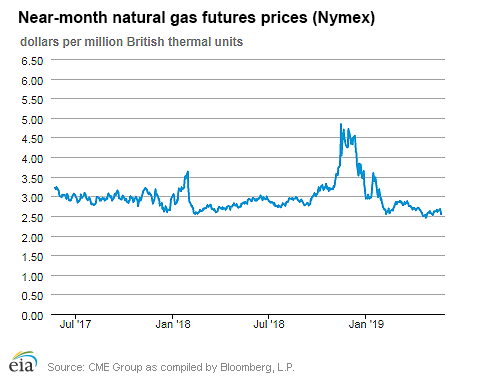
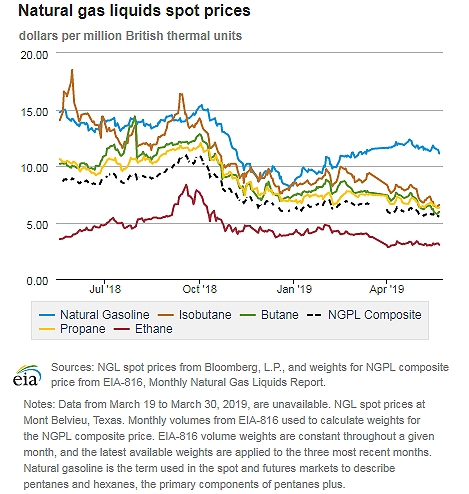
| U.S. natural gas supply - Gas Week: (5/16/19 - 5/22/19) | |||
|---|---|---|---|
Average daily values (Bcf/d): |
|||
this week |
last week |
last year |
|
| Marketed production | 99.3 |
100.0 |
90.1 |
| Dry production | 88.6 |
89.2 |
80.3 |
| Net Canada imports | 4.9 |
4.7 |
6.0 |
| LNG pipeline deliveries | 0.1 |
0.1 |
0.1 |
| Total supply | 93.6 |
94.0 |
86.4 |
|
Source: OPIS PointLogic Energy, an IHS Company | |||
| U.S. natural gas consumption - Gas Week: (5/16/19 - 5/22/19) | |||
|---|---|---|---|
Average daily values (Bcf/d): |
|||
this week |
last week |
last year |
|
| U.S. consumption | 58.9 |
60.4 |
58.4 |
| Power | 25.5 |
23.9 |
27.3 |
| Industrial | 20.0 |
20.4 |
20.1 |
| Residential/commercial | 13.4 |
16.2 |
11.0 |
| Mexico exports | 4.6 |
4.7 |
4.4 |
| Pipeline fuel use/losses | 5.9 |
6.0 |
5.5 |
| LNG pipeline receipts | 5.6 |
5.8 |
2.9 |
| Total demand | 75.0 |
76.9 |
71.2 |
|
Source: OPIS PointLogic Energy, an IHS Company | |||
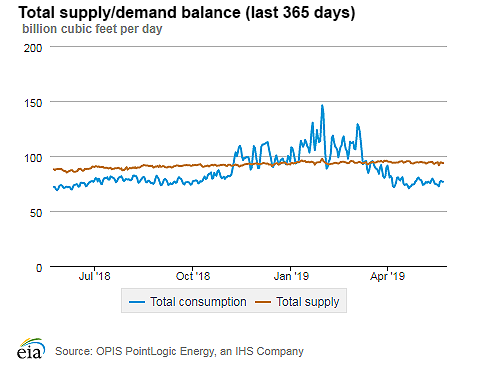
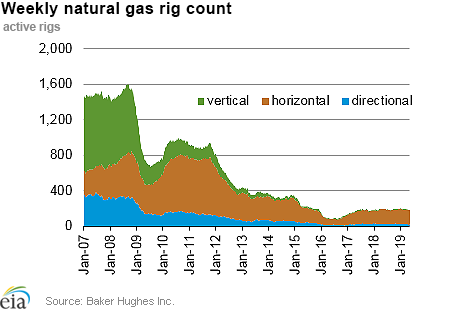
| Rigs | |||
|---|---|---|---|
Tue, May 14, 2019 |
Change from |
||
last week |
last year |
||
| Oil rigs | 802 |
-0.4% |
-5.0% |
| Natural gas rigs | 185 |
1.1% |
-7.5% |
| Note: Excludes any miscellaneous rigs | |||
| Rig numbers by type | |||
|---|---|---|---|
Tue, May 14, 2019 |
Change from |
||
last week |
last year |
||
| Vertical | 48 |
6.7% |
-21.3% |
| Horizontal | 866 |
-0.7% |
-5.8% |
| Directional | 73 |
2.8% |
10.6% |
| Source: Baker Hughes Inc. | |||
| Working gas in underground storage | ||||
|---|---|---|---|---|
Stocks billion cubic feet (Bcf) |
||||
| Region | 2019-05-17 |
2019-05-10 |
change |
|
| East | 353 |
330 |
23 |
|
| Midwest | 364 |
336 |
28 |
|
| Mountain | 89 |
82 |
7 |
|
| Pacific | 186 |
174 |
12 |
|
| South Central | 762 |
731 |
31 |
|
| Total | 1,753 |
1,653 |
100 |
|
|
Source: Form EIA-912, Weekly Underground Natural Gas Storage Report | ||||
| Working gas in underground storage | |||||
|---|---|---|---|---|---|
Historical comparisons |
|||||
Year ago (5/17/18) |
5-year average (2014-2018) |
||||
| Region | Stocks (Bcf) |
% change |
Stocks (Bcf) |
% change |
|
| East | 296 |
19.3 |
369 |
-4.3 |
|
| Midwest | 285 |
27.7 |
416 |
-12.5 |
|
| Mountain | 106 |
-16.0 |
131 |
-32.1 |
|
| Pacific | 212 |
-12.3 |
245 |
-24.1 |
|
| South Central | 718 |
6.1 |
867 |
-12.1 |
|
| Total | 1,616 |
8.5 |
2,027 |
-13.5 |
|
| Source: Form EIA-912, Weekly Underground Natural Gas Storage Report | |||||
| Temperature – heating & cooling degree days (week ending May 16) | ||||||||
|---|---|---|---|---|---|---|---|---|
HDD deviation from: |
CDD deviation from: |
|||||||
| Region | HDD Current |
normal |
last year |
CDD Current |
normal |
last year |
||
| New England | 95 |
28 |
18 |
0 |
0 |
0 |
||
| Middle Atlantic | 77 |
23 |
32 |
0 |
-3 |
-3 |
||
| E N Central | 82 |
23 |
28 |
1 |
-8 |
-2 |
||
| W N Central | 66 |
15 |
18 |
9 |
-2 |
-9 |
||
| South Atlantic | 24 |
2 |
23 |
45 |
9 |
-18 |
||
| E S Central | 26 |
6 |
25 |
23 |
-3 |
-28 |
||
| W S Central | 15 |
9 |
13 |
38 |
-14 |
-17 |
||
| Mountain | 48 |
-17 |
2 |
19 |
1 |
2 |
||
| Pacific | 27 |
-14 |
-9 |
1 |
-6 |
0 |
||
| United States | 53 |
9 |
17 |
16 |
-2 |
-8 |
||
|
Note: HDD = heating degree day; CDD = cooling degree day Source: National Oceanic and Atmospheric Administration | ||||||||
Average temperature (°F)
7-day mean ending May 16, 2019
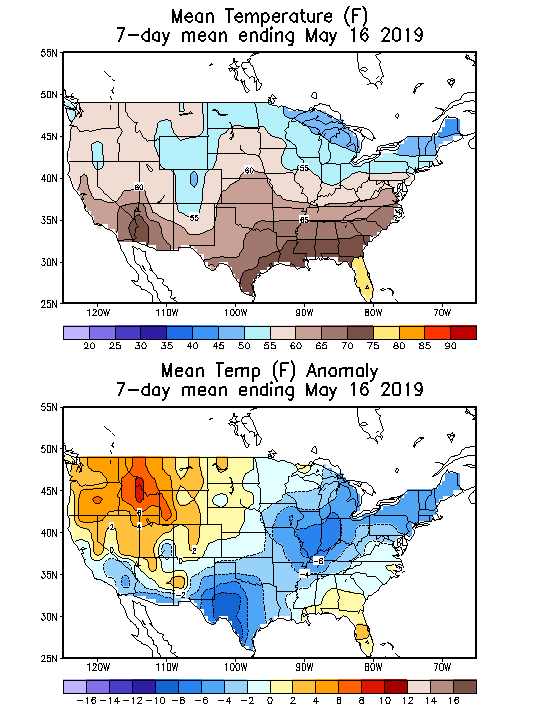
Source: National Oceanic and Atmospheric Administration
Deviation between average and normal (°F)
7-day mean ending May 16, 2019

Source: National Oceanic and Atmospheric Administration

